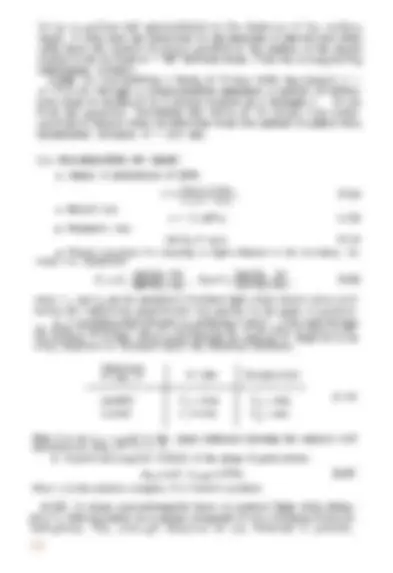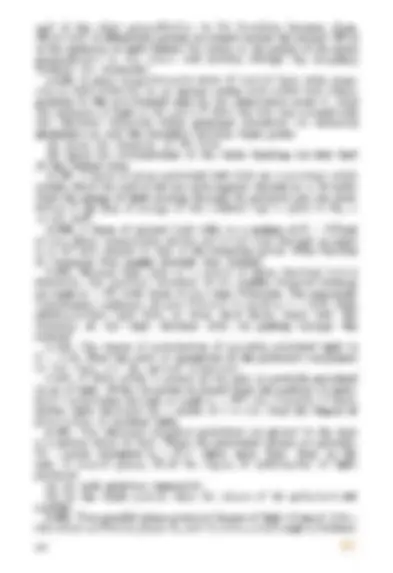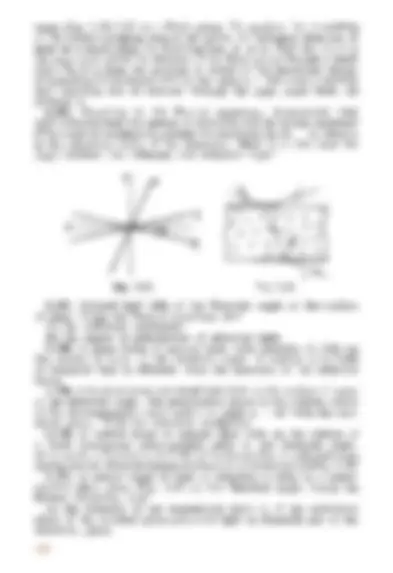





Study with the several resources on Docsity

Earn points by helping other students or get them with a premium plan


Prepare for your exams
Study with the several resources on Docsity

Earn points to download
Earn points by helping other students or get them with a premium plan
Community
Ask the community for help and clear up your study doubts
Discover the best universities in your country according to Docsity users
Free resources
Download our free guides on studying techniques, anxiety management strategies, and thesis advice from Docsity tutors
irodov_problems_in_general_physics_2011
Typology: Study Guides, Projects, Research
1 / 5

This page cannot be seen from the preview
Don't miss anything!




Fig. 5.28.
5.141. With light falling normally on a transparent diffraction grating 10 mm wide, it was found that the components of the yellow line of sodium (589.0 and 589.6 nm) are resolved beginning with the fifth order of the spectrum. Evaluate: (a) the period of this grating; (b) what must be the width of the grating with the same period for a doublet k = 460.0 nm whose components differ by 0.13 nm to be resolved in the third order of the spectrum. 5.142. A transparent diffraction grating of a quartz spectrograph is 25 mm wide and has 250 lines per millimetre. The focal length of an objective in whose focal plane a photographic plate is located is equal to 80 cm. Light falls on the grating at right angles. The spectrum under investigation includes a doublet with components of wavelengths 310.154 and 310.184 nm. Determine: (a) the distances on the photographic plate between the components of this doublet in the spectra of the first and the second order; (b) whether these components will be resolved in these orders of the spectrum. 5.143. The ultimate resolving power VSX of the spectrograph's trihedral prism is determined by diffraction of light at the prism edges (as in the case of a slit). When the prism is oriented to the least deviation angle in accordance with Rayleigh's criterion, A,/SA, = b I dnIcA, I,
where b is the width of the prism's base (Fig. 5.28), and dnIdk (^) is the dispersion of its material. Derive this formula.
5.144. A spectrograph's trihedral prism is manufactured from glass whose refractive index varies with wavelength as n = A + where A and B are constants, with B being equal to 0.010 1.tra2. Making use of the formula from the foregoing problem, find: (a) how the resolving power of the prism depends on k; calculate the value of kin in the vicinity of ki= 434 nm and 21,2 = 656 nm if the width of the prism's base is b = 5.0 cm; (b) the width of the prism's base capable of resolving the yellow doublet of sodium (589.0 and 589.6 nm). 5.145. How wide is the base of a trihedral prism which has the same resolving power as a diffraction grating with 10 000 lines
224
5.146. There is a telescope whose objective has a diameter D = 5.0 cm. Find the resolving power of the objective and the mini- mum separation between two points at a distance 1 = 3.0 km from the telescope, which it can resolve (assume X = 0.55 pm). 5.147. Calculate the minimum separation between two points on the Moon which can be resolved by a reflecting telescope with mirror diameter 5 m. The wavelength of light is assumed to be equal to X = 0.55 pm. 5.148. Determine the minimum multiplication of a telescope with diameter of objective D = 5.0 cm with which the resolving power of the objective is totally employed if the diameter of the eye's pupil is do= 4.0 mm. 5.149. There is a microscope whose objective's numerical aperture is sin a = 0.24, where a is the half-angle subtended by the objec- tive's rim. Find the minimum separation resolved by this microscope when an object is illuminated by light with wavelength X = 0.55 p,m. 5.150. Find the minimum magnification of a microscope, whose objective's numerical aperture is sin a = 0.24, at which the resolv- ing power of the objective is totally employed if the diameter of the eye's pupil is do= 4.0 mm. 5.151. A beam of X-rays with wavelength 2,, falls at a glancing angle 60.0° on a linear chain of scattering centres with period a. Find the angles of incidence corres- ponding to all diffraction maxima YA if X = 2a/5. (^) • • 5.152. A beam of X-rays with (^) • • • • wavelength X, = 40 pm falls nor- (^). ..... mally on a plane rectangular array of scattering centres and produces a system of diffraction maxima •^ • (Fig. 5.29) on a plane screen re- moved from the array by a distance 1 = 10 cm. Find the array periods a and b along the x and y axes if the Fig. 5.29. distances between symmetrically located maxima of second order are equal to Ax = 60 mm (along the x axis) and Ay = 40 mm (along the y axis). 5.153. A beam of X-rays impinges on a three-dimensional rectan- gular array whose periods are a, b,^ and^ c.^ The direction of the inci- dent beam coincides with the direction along which the array period is equal to a. Find the directions to the diffraction maxima and the wavelengths at which these maxima will be observed. 5.154. A narrow beam of X-rays impinges on the natural facet of a NaC1 single crystal, whose density is p = 2.16 g/cm3at a glanc- ing angle a = 60.0°. The mirror reflection from this facet produces a maximum of second order. Find the wavelength of radiation. 5.155. A beam of X-rays with wavelength X = 174 pm falls on the surface of a single crystal rotating about its axis which is paral-
15 --9451 (^225)
and of the other perpendicular, to the boundary between them. What kind of diffraction pattern is formed behind the screen? What is the intensity of light behind the screen at the points of the plane perpendicular to the screen and passing through the boundary between the Polaroids? 5.158. A plane monochromatic wave of natural light with inten- sity I, falls normally on an opaque screen with round hole corres-
two identical Polaroids whose principal directions are mutually perpendicular and the boundary between them passes (a) along the diameter of the hole; (b) along the circumference of the circle limiting the first half of the Fresnel zone. 5.159. A beam of plane-polarized light falls on a polarizer which rotates about the axis of the ray with angular velocity a) = 21 rad/s. Find the energy of light passing through the polarizer per one revo- lution if the flux of energy of the, incident ray is equal to D0 = = 4.0 mW.
prisms whose transmission planes are turned each through an angle cp = 30° with respect to that of the foregoing prism. What fraction of luminous flux passes through this system? 5.161. Natural light falls on a system of three identical in-line Polaroids, the principal direction of the middle Polaroid forming an angle p = 60° with those of two other Polaroids. The maximum
plane-polarized light falls on them. How many times will the intensity of the light decrease after its passing through the system? 5.162. The degree of polarization of partially polarized light is
of this light and the natural component. 5.163. A Nicol prism is placed in the way of partially polarized beam of light. When the prism is turned from the position of maxi- mum (^) transmission through an angle cp = 60°, the intensity of trans- mitted light decreased by a factor of ri = 3.0. Find the degree of polarization of incident light. 5.164. Two identical imperfect polarizers are placed in the way of a natural beam of light. When the polarizers' planes are parallel, the system transmits rt = 10.0 times more light than in the case of crossed planes. Find the degree of polarization of light produced (a) by each polarizer separately; (b) by the whole system when the planes of the polarizers are parallel. 5.165. Two parallel plane-polarized beams of light of equal inten- sity whose oscillation planes NIand N2 form a small angle cp between
15•
them (Fig. 5.30) fall on a Nicol prism. To equalize the intensities of the beams emerging behind the prism, its principal direction N must be aligned along the bisecting line A or B. Find the value of the angle y at which the rotation of the Nicol prism through a small angle 6y << q from the position A results in the fractional change of intensities of the beams AIII^ by the value r' = 100 times exceeding that resulting due to rotation through the same angle from the position B. 5.166. Resorting to the Fresnel equations, demonstrate that light reflected from the surface of dielectric will be totally polarized if the angle of incidence 0, satisfies the condition tan 0, = n, where n is the refractive index of the dielectric. What is in this case the angle between the reflected and refracted rays?
Fig. 5.30. Fig. 5.31.
5.167. Natural light falls at the Brewster angle on the surface of glass. Using the Fresnel equations, find (a) the reflection coefficient; (b) the degree of polarization of refracted light. 5.168. A plane beam of natural light with intensity / 0falls on the surface of water at the Brewster angle. A fraction p = 0. of luminous flux is reflected. Find the intensity of the refracted beam. 5.169. A beam of plane-polarized light falls on the surface of water at the Brewster angle. The polarization plane of the electric vector of the electromagnetic wave makes an angle y = 45° with the inci- dence plane. Find the reflection coefficient. 5.170. A narrow beam of natural light falls on the surface of a thick transparent plane-parallel plate at the Brewster angle. As a result, a fraction p = 0.080 of luminous flux is reflected from its top surface. Find the degree of polarization of beams 1-4 (Fig. 5.31) 5.171. A narrow beam of light of intensity / 0falls on a plane- parallel glass plate (Fig. 5.31) at the Brewster angle. Using the Fresnel equations, find: (a) the intensity of the transmitted beam 1:4 if the oscillation plane of the incident plane-polarized light is perpendicular to the incidence plane;
228